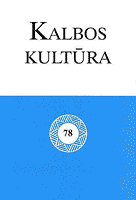Kreipimosi į adresatą būdai reklamoje
Forms of address in advertising
Author(s): Asta Kupčinskaitė-Ryklienė, Jurgita GirčienėSubject(s): Language and Literature Studies
Published by: Lietuvių Kalbos Institutas
Keywords: Address; advertising; usage; familiar form; polite form
Summary/Abstract: The paper discusses the usage of tu ('you'Sg) and jūs ('you'Pl), a pair of stylistic synonyms, in Lithuanian print advertisements. The analysis has resulted in identifying that tu, as a familiar singular form, is most popular in advertisements targeted at young people, especially younger men. The form of address can be characterised as maintaining a friend-to-friend (both male and female) relationship. The increasing frequency of the familiar form of address could be treated as confirming the well-established difference between the communication among young people and that among the older generation. It could also signal the emergence of a new attribute of freer culture. Jūs, as a more respectable form of address, expressed in the plural number but standing for the singular, is frequently chosen by those who try in their advertisements to appeal to women of different ages, elderly people of both sexes, or to an unidentified addressee with a business-like interest. In the latter case, the relation between the addressor and the addressee could be defined as an adviser to an inquirer or a professional to an amateur. The neutral plural form is used in advertising consumer goods, otherwise known as family goods. The target audience has almost no impact on the choice of the medium. In individual cases, both singular and plural forms of address are used in one and the same advertisement. In some, though not all, cases, the usage is well grounded. In making a choice between the familiar form tu and the polite jūs, the authors of the print advertisements should take into account factors determining the choice between the two forms in spoken language as well as their aptitude for the selected form and the medium, the target audience and general stylistic requirements.
Journal: Bendrinė kalba (iki 2014 metų – Kalbos kultūra)
- Issue Year: 2005
- Issue No: 78
- Page Range: 220-230
- Page Count: 11
- Language: Lithuanian

